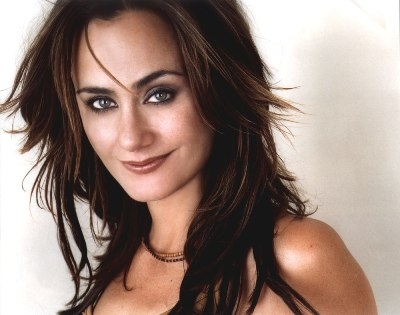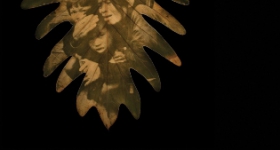There is much in Diane Farr’s memoir Kissing Outside the Lines to put one off. First of all, there is the tasteless and unnecessary cover photo: A naked, fair-skinned blonde woman is lying on her back, legs up and crossed at the ankles, hands covering her breasts. It is obviously not Farr; Farr, as she describes herself numerous times in the book, is a brunette with olive skin. Why then this photo? Two hundred eighty pages later, I still couldn’t figure it out.
Then there’s the cringe-worthy manner in which she describes her first encounter with her husband: from across the dance floor at a wedding, she beckons to him with one finger, while pulling her eye into a slant with another. The rest of that section explains her husband-to-be’s good looks in the following way: “Shoulders as wide as his reside only above the Mekong because his ancestors had to work the land without the help of a river. I ran my finger over his face, saying his amazing cheekbones were so prominent because Koreans are direct descendants of the Mongols.” I’m not kidding.
And not in the least, Farr herself is a white woman writing about race.
But ultimately, she won me over. Not because the writing was particularly good, or because her story was particularly compelling, but because there’s a certain honesty and determined effort that comes through in her attempts to comprehend the complexities of navigating an interracial marriage.
An actress who has appeared in shows such as Numb3rs and Californication, Farr has written extensively for newspapers and magazines, and previously published a book called Girl Code. In this sophomore feature, Farr details her path to marriage and into the happily thereafter with a Korean American man. She sets herself up as an experienced writer, and she certainly approaches writing with a certain flair. A strong sense of self and identity comes through when she describes her own upbringing and how it informs her worldview, and this attitude works in her favor when she delves into identity politics. You can hold her whiteness and privilege against her, but Farr has made clear and calculated efforts to examine the system of racism and race relations around her.

Photo of the author by Laura Kate Jones
Crucial parts of her racial “explorations” include interviews with friends who are themselves in interracial relationships. There’s the quintessential black-white pairing, a white girl with a South Asian boy, the Mexican American and with the British Palestinian. No two relationships are the same, and Farr understands these unions not as blueprints for her own path, but more as comforting reminders that she’s not alone in her struggles.
Speaking of struggles, Farr’s situation isn’t nearly as difficult as she’d have you imagine. In fact, as far as interracial relationships go, she’s positively lucky. Her primary points of contention aren’t even with her immediate family or in-laws, but with her husband Seung’s extended family. While Seung had to deal with some discomfort when coming out to his father as an Anglophile, his parents were “warm and lovely” when they met Farr for the first time. His sister, too, is fun and friendly with Farr. By the end of the book, one wonders if all the racial conflicts Farr experiences are mostly in her head.
That’s not to say her path was without real issues. Seung’s extended family snubs her, certainly, and her own family injects their own strain of white neuroses into the equation -- her brothers make clumsily racist jokes and Farr worries about her acrimoniously divorced parents seeing each other at the wedding. But when your parents love your fiancé and your future in-laws greet you with warmth and kindness, one of the most crucial battles in interracial dating has already been won.
What Farr’s narrative lacks most is a more detailed account of the development of her courtship with her husband. For me, the disconnect is the lack of storytelling relating the blossoming of the relationship. Farr basically announces a sequence of weddings where she spies her “Giant Korean” and hooks up with other men. I suppose this is meant to convey her fun-ness and sex positivity, but really, it just bypasses the part where we pick up on the tension and chemistry between two would-be lovers, and leaves out a critical opportunity for us to connect with the protagonists of this journey.
Kissing Outside the Lines is not a bad read by any means, and Farr is a convivial narrator. And I did come away with a key piece of information: if planning your own wedding, never tell the service provider that it’s for a wedding, lest you wish to incur a three-fold increase in price.









Comments